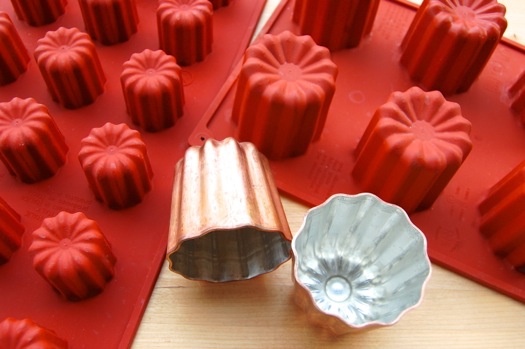How to go broke on gear in one easy step.

Buy lots of cannelé molds. As you can see here I’ve acquired a few different kinds over the years, and have made lousy cakes in all of them. The most expensive of these by far are the little copper cups in the middle there. Those are about two inches tall, hold a single cannelé each, and cost about twenty bucks (U.S.) apiece. I know what you’re thinking: maybe I can just buy a couple of the good ones and bake several rounds of batter in sequence. Not really, since each batch bakes for two hours. You’ll be up all night making four mouthfuls of cannelé at a go. Nope, unless you have lots of disposable income you’re going to want to go with silicone, at least to start. It doesn’t deliver an exterior nearly as crisp as the metal molds do, but at least you won’t be broke AND aggravated over a failed batch at the very same time.
I should add that traditionally the metal molds are lubricated with a 50-50 cocktail of melted butter and beeswax. That may be the super-secret key to a truly authentic cannelé, but then you can’t exactly get beeswax at the corner store. I find it’s best with these sorts of affairs to set your sights on what’s achievable first and pursue perfection later…after you get your next raise.
You can often find beeswax at hardware stores as it’s used for finishing wood. Wouldn’t really be food grade though although you can sometimes find pure beeswax. Unfortunately it most likely won’t be produced in a sanitary environment and won’t be good for consumption.
Hey Julie!
You can also find it in art supply stores, but just as with hardware stores you really don’t know if it’s food safe. Having been a beekeeper I know that wax from the hive is harmless, but there’s no telling how the wax may have been processed.
Thanks for the comment!
– Joe
I use a six-pack silicone mold like you picture in the back right. For me the texture (exterior crispness and creamy interior) has been fairly good provided they are cooked long enough. The exterior texture tends to reduce after several hours. I’d guess that beewax would help the exterior hold it’s crispiness longer, but I’m not ready to invest in copper quite yet. But I like the taste even after they’ve “gone soggy”.
Thanks, Brian!
That’s encouraging.
– Joe
Oops. I meant “8-pack” mold. 4 x 2 = 8… right?
Exactly…I forgot my elementary school math and called it a 10-mold yesterday. Sigh. I knew I should have studied for those tests…
– J
Joe, my farmers’ market always has a couple of honey vendors, who also sell beeswax.
I have purchased it for a recipe I use for maintaining wooden kitchen gadgets (spoons, bowls, boards, etc.).
Not that you need to go for the beeswax method, but if you really want to …
Well, here’s where my obscure knowledge comes in. Long ago somehow I found out about Fante’s in Philadelphia. I’ve never ordered from them, but I look through their offerings. One day I’ll get there and buy, among other items, the food grade beeswax (though I want to use it on wooden cooking utensils). You and Fantes – two of the best sites on the internet.
I’m flattered, Naomi!
And I may well cave and try some with beeswax before this is all over. Who knows?
– Joe
So why would not a popover pan not be a good substitute? Size?
That’s exactly it. Popover pans are quite large for canneles, but I wouldn’t cry foul if you tried it!
– Joe
If you filled a standard popover cup halfway (or one-third or one-quarter), would the shape, texture and size work out correctly otherwise?
That would work I think , charm, though maybe only a third of the way or so is my thought. Just a couple of ounces of batter.
Let me know how they go!
– Joe
Why are super expensive copper, or affordable but poorly conducting silicone the only two options? Surely a metal version of the silicone pan would be as cheap, and yield results much closer to the copper molds?
I remember as a teenager, I once baked a batch of crisp, creamy centred cannelés in a metal muffin pan.
Hey Gretchen!
I’ve heard about, but never seen, aluminum cups. I don’t know how well they work but that may be another option. Obviously, affordable cannelé molds aren’t what the market is clamoring for, otherwise fabricators would probably make more of them!
Cheers,
– Joe
Allow me to firstly state that I hate cannelés. Way too much bother for what they are. That having been said, I know a guy who is reknowned for them and emphatically claims that they can ONLY be done in copper molds. Thought I’d pass that on even if I am skeptical.
I was also under the impression that “cannelé” came from “cannellé” which would translate to “cinnamoned” or “cinnamon-covered.” (Which always struck me as strange since few recipes even use cinnamon)
Cheers
I haven’t found any references to that, Paul, but I’ll put it in the hopper.
– Joe